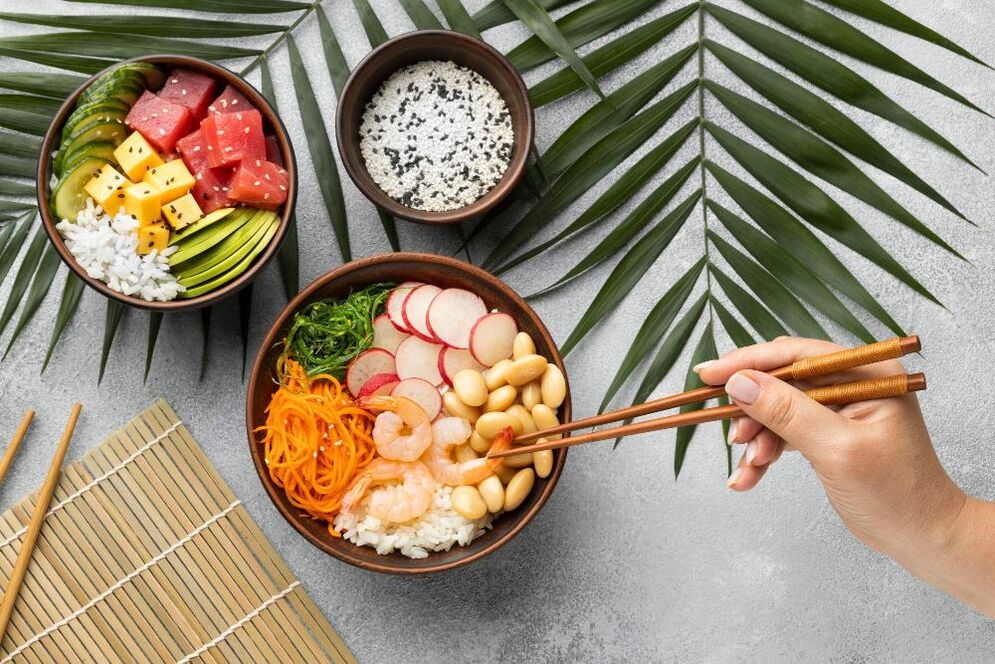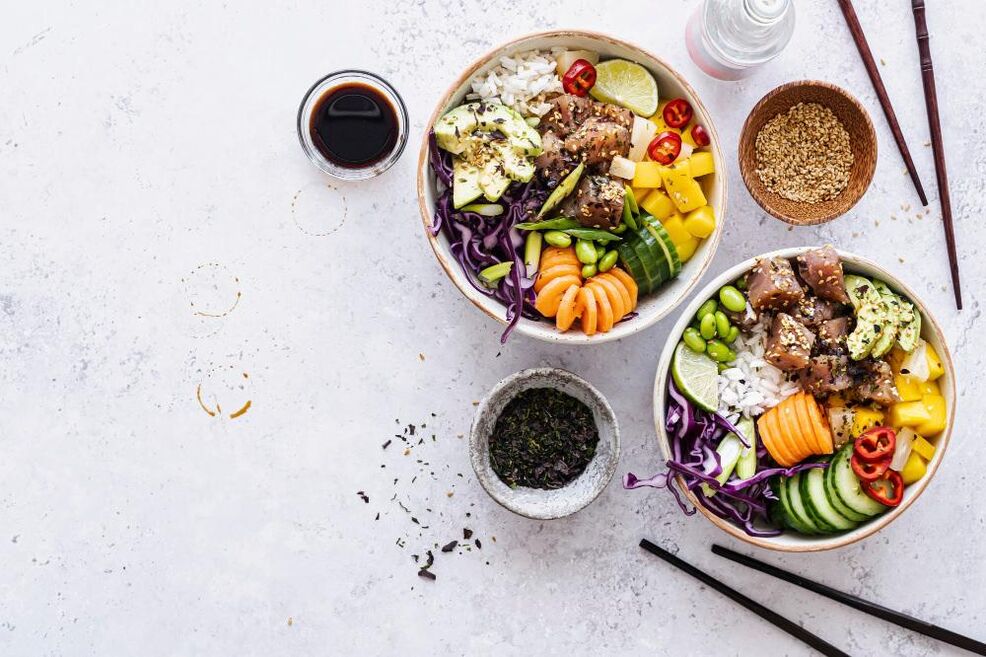Almost every second girl is dissatisfied with her weight. And to lose the hated kilos, they use everything: laxative teas, vomiting inducers, fasting, body wraps, cocktails. Some naive girls dream of losing weight without doing anything.
All diets are beneficial to some extent. Some give quick results, while others take some getting used to. The Japanese are fanatics about discipline. In every business, the system and rules are strictly followed, without which success is impossible. The same principle is followed in food.
The Japanese diet is also good because the hated kilos do not return even after it ends. But there is a nuance: if you do not follow the rules, there will be no result. How to reach the desired weight? The answer is in the article.

What is the essence of the Japanese diet?
This diet lasts for two weeks. Short time compared to other diets. The basic rule is to emphasize low-calorie foods and protein-rich foods. Carbohydrates - to a minimum.
The expected result of the Japanese diet is minus 5-8 kg. Approximate food cost is about a few tens of dollars. But since the diet is very strict, you must strictly follow the rules. And this requires enormous will power. And you also need to complete the diet correctly - then the results will be permanent.
- Contraindicated for pregnant and lactating women.
- Contraindicated for people suffering from gastritis and stomach ulcers, liver, kidney and cardiovascular diseases.
A doctor's consultation is mandatory before starting the diet!
name origin
When people hear the words Japan and "Japanese cuisine", they immediately think of the familiar sushi, sashimi, funchose, seafood, etc. The menu of the Japanese diet is predominantly low-calorie, but there is no abundant rice. But there is boiled fish and eggs.
All products are already known, there are practically no allergic reactions. Any diet product can be purchased in any store. There will be no problems with availability and purchase.
- The menu was compiled by Japanese nutritionists from a clinic in Tokyo.
- Clear and simple chart based on Japanese philosophy. The principle is simple: put in maximum effort and get the well-deserved reward.
Many people who watched Japanese films could not help but notice their dietary restraint. Asians stay slim and healthy almost to old age. The food is consumed in portions, all products in it are low in calories. Moderation and low calorie intake are the basic principles of the Japanese diet. Japanese nutritionist Naomi Moriyama is sure that this is the secret of Japanese longevity. The proof was in his research. He found that the Japanese consume 25% fewer calories per day than other peoples. They don't like junk food, chips and sweets.
Basic rules of the Japanese diet
How difficult is weight loss for us? It's in the restrictions. Golden dream: eat everything you want without getting fat. We are not used to restrictions, so sticking to a diet will be very difficult. Despite the food's B, F and U content, the diet is very strict. Nevertheless, there are enough nutrients in the diet. Every product is a source of one thing or another.
- Vegetables.
- Fruits.
- Dried bread.
- Fish.
- Meat.
- Olive oil.
- Chicken meat.
- Dairy products.
- Egg.
- Fish.
- Beef.
A significant advantage is the absence of discomfort in the gastrointestinal tract. There will be no bloating, flatulence or constipation. Fiber, essential for normal digestion, is found in fruits and vegetables.
In addition, coffee and tea are allowed for some. They provide the necessary tone and energy, as well as antioxidants. Of course, we need good quality products: no freeze-dried coffee or tea bags. Only grains or ground and leafy greens. Black tea is not recommended.
If you feel sick or have a headache, it is better to stop the diet. And consult your doctor.
Don't forget about water during the diet. The daily norm is 1. 5-2 liters of still water. There is a useful life hack that many people know. It helps to "trick" the stomach and alleviate the feeling of hunger. To do this, drink a glass of warm or room temperature water 15-20 minutes before a meal.
If you strictly follow the rules of the Japanese diet, the expected result will come true. But products cannot be exchanged. Sugar and whole milk in coffee or tea are strictly prohibited. Salt too. If you really can't stand it, then spice it up to a minimum.
The frequency of meals is 3 times a day. Many diets advise 5-6 times. But that is not given here. There are no snacks. You can eat your last meal a few hours before going to bed. A mandatory rule is a glass of warm water in the morning on an empty stomach. It kick-starts the metabolism and suppresses hunger.
Another rule of the diet: mandatory preliminary preparation. A week before the diet, you should exclude sweets, pastries, hamburgers and French fries. Food portions should be gradually reduced. And you need to prepare yourself psychologically, because it will be difficult to eat the same thing for two weeks.

Essential foods for the Japanese diet
As we wrote above, the products cannot be exchanged. Otherwise, you will not get the desired result.
- Loose green tea: unflavored.
- Good beans or ground coffee.
- Tomato juice: 1 l.
- Every day - fresh (! ) Kefir, 1 liter.
- Medium white cabbage - 2 heads.
- Eggplant and zucchini - 0. 5 kg each.
- Carrot - 2-3 kg.
- Any fruit (except bananas and grapes) - 1 kg.
- Lemon - 2 pcs.
- Lean beef - 1 kg.
- Chicken meat without skin and bones - 1 kg.
- Sea fish without bones - 1 kg.
- Chicken eggs - 20 pcs.
- Olive oil (cold pressed) - 0. 5 l.
The similarity of the diet with the "chemical" diet
Some diets are very similar in their nutritional principles. For example, Japanese is similar to the chemical suggested by Osama Hamdiy for diabetics. The principle of nutrition in the Japanese diet is more B, minimum U. Thanks to this, the mechanism of burning fat reserves starts. No new ones appear.
The only difference is that the chemical diet does not limit portion sizes. The diabetic eats and exercises calmly. And nutrition in the Japanese diet limits variety: U - little, B - a lot, the products are the same. But its duration is only 2 weeks.
Japanese diet menu
It's pretty monotonous. There is no breakfast at all, or only coffee with some bread or biscuits. They usually eat a lot of protein and vegetables for lunch. And dinner is heartier: boiled meat or fish. Plus kefir.
If you don't want to bother with the menu, download a special application. It gives advice on certain foods and what to make of them. The downside is the English language interface.
The Japanese diet is attractive because the results can last for 3 years or more. The main thing is that it lasts for 2 weeks. And of course, continue to watch your diet. According to the Japanese, the best products are healthy and natural. And the main principle is not to eat too much.
Advantages
Despite its strictness, this diet has many benefits. One is quick results in just 2 weeks.
- Long-term preservation of the achieved results (with proper nutrition and moderate dosage).
- Release from waste and toxins. The intestines are cleansed thanks to the intake of fiber and water.
- Significant budget savings. The products are cheap and accessible.
- Improvement of the complexion and general condition of the skin. Hair and nails become stronger.
- You feel good.
- Almost all products are hypoallergenic.
Mistakes
One of the disadvantages is the strict restrictions. Not everyone can resist 2 weeks of monotonous nutrition. When you can't even treat yourself to chocolate.
- Preliminary physiological and psychological preparation.
- No snacks, no "normal" breakfast. Constant hunger.
- Monotonous menu.
- Imbalance.
- A wide list of contraindications.
14-day expected results of the Japanese diet
Every body is completely unique and the result may vary. Some people lose 8 kg or more, while others only lose 1 kg. Evaluations of those who lose weight show an average of 5-14 kg in two weeks. But don't rush to rejoice: even if you lose 5 kg or more in the first week, it may just be excess fluid.
People also tolerate diets differently. Some people survive 2 weeks without difficulty, while others break down in the first 3 days. Those who have tried the diet say that it is difficult only in the first days, then it becomes easier. Some people said that coffee saved them. It is very difficult to eat cabbage all the time.
To check whether the weight has been reduced or not, first measure the volume of the abdomen and hips. First, the volumes disappear, then the weight itself. So if you notice that your belly has become smaller and the breeches are slowly disappearing from your hips, then you are on the right track.
Conclusion
A beautiful body and figure always demand certain sacrifices from a person. Everyone eats, and only witches don't gain weight. It's not like you can eat everything and not face the consequences. And of course, physical activity helps to maintain the body. But before any diet, you should consult a doctor. The Japanese diet may be unhealthy and undermine your health.
It also happens that no diet helps. No matter how much you sit on the restrictions, the weight will either stay or increase. Then you have to go to the doctor. You may have a hormonal imbalance or thyroid problem. Contact an endocrinologist, he will prescribe glucose, thyroid ultrasound, hormone, testosterone, cortisol and other tests. Then it turns out: you need a diet or medicine.

































